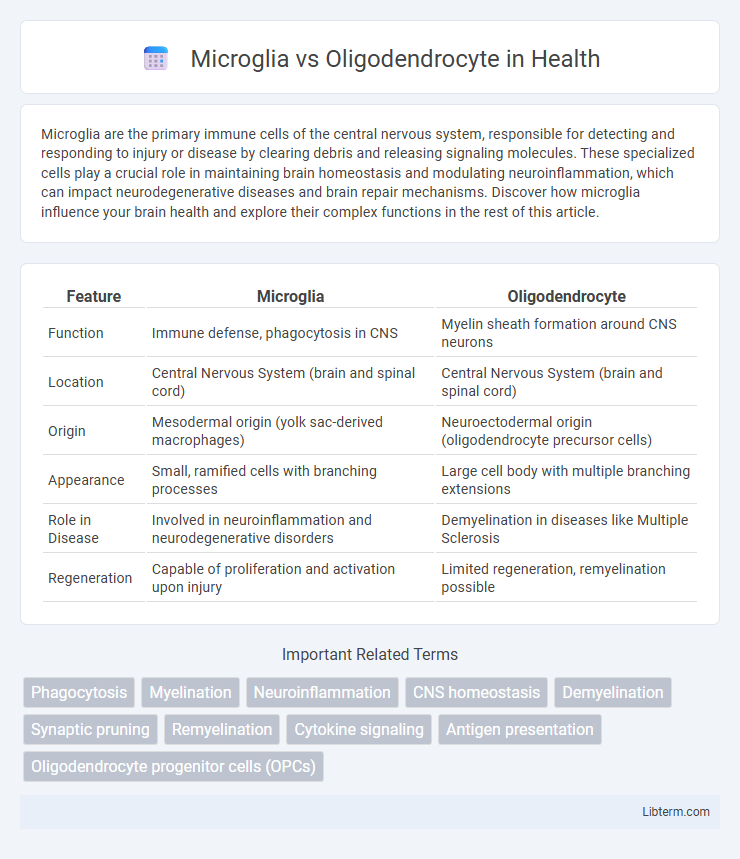Microglia are the primary immune cells of the central nervous system, responsible for detecting and responding to injury or disease by clearing debris and releasing signaling molecules. These specialized cells play a crucial role in maintaining brain homeostasis and modulating neuroinflammation, which can impact neurodegenerative diseases and brain repair mechanisms. Discover how microglia influence your brain health and explore their complex functions in the rest of this article.
Table of Comparison
| Feature | Microglia | Oligodendrocyte |
|---|---|---|
| Function | Immune defense, phagocytosis in CNS | Myelin sheath formation around CNS neurons |
| Location | Central Nervous System (brain and spinal cord) | Central Nervous System (brain and spinal cord) |
| Origin | Mesodermal origin (yolk sac-derived macrophages) | Neuroectodermal origin (oligodendrocyte precursor cells) |
| Appearance | Small, ramified cells with branching processes | Large cell body with multiple branching extensions |
| Role in Disease | Involved in neuroinflammation and neurodegenerative disorders | Demyelination in diseases like Multiple Sclerosis |
| Regeneration | Capable of proliferation and activation upon injury | Limited regeneration, remyelination possible |
Introduction to Microglia and Oligodendrocytes
Microglia are the primary immune cells of the central nervous system, responsible for detecting and responding to pathogens, clearing debris, and modulating inflammation to maintain neural homeostasis. Oligodendrocytes are specialized glial cells that produce myelin sheaths, essential for insulating axons and facilitating rapid electrical signal transmission in the brain and spinal cord. Both cell types play critical roles in neural health, with microglia focusing on immune defense and oligodendrocytes supporting neuronal conductivity.
Origins and Developmental Pathways
Microglia originate from yolk sac progenitors during early embryogenesis and migrate to the central nervous system (CNS) where they differentiate into resident immune cells, playing critical roles in immune surveillance and neuroinflammation. Oligodendrocytes arise from neuroectodermal precursor cells within the ventricular zone of the developing neural tube, undergoing a distinct developmental pathway that involves proliferation, migration, and differentiation to form myelin-producing cells essential for axonal insulation and rapid nerve conduction. The divergent embryonic origins highlight the unique functions of microglia as innate immune cells and oligodendrocytes as key participants in nervous system myelination.
Distinct Morphological Features
Microglia exhibit small, dense cell bodies with numerous thin, highly branched processes adapted for immune surveillance and rapid response to CNS injury. Oligodendrocytes possess larger, rounder cell bodies with fewer, thicker processes specialized in forming myelin sheaths around multiple axons, facilitating efficient neural signal conduction. The distinct morphology reflects their divergent functions: microglia as resident immune cells and oligodendrocytes as principal myelinating glia in the central nervous system.
Core Functions in the Central Nervous System
Microglia serve as the primary immune cells in the central nervous system, responsible for detecting and responding to pathogens, clearing cellular debris, and modulating inflammation to maintain neural homeostasis. Oligodendrocytes specialize in producing myelin sheaths that insulate axons, enabling rapid electrical signal transmission and supporting neuronal function. Together, microglia and oligodendrocytes play complementary roles in CNS health by balancing immune defense and neural signal integrity.
Microglia: Guardians of Neural Immunity
Microglia serve as the primary immune defenders within the central nervous system, constantly surveying and responding to pathogens, cellular damage, and inflammation. Unlike oligodendrocytes, which specialize in myelination and neural conductivity, microglia perform crucial roles in synaptic pruning and neuroinflammation regulation. Their activation states dynamically influence neurodegenerative diseases and brain homeostasis, making them key targets for therapeutic interventions in conditions like Alzheimer's and multiple sclerosis.
Oligodendrocytes: Myelination and Neural Conduction
Oligodendrocytes play a crucial role in the central nervous system by forming the myelin sheath around axons, which facilitates rapid neural conduction through saltatory conduction. This myelination enhances the speed and efficiency of electrical signal transmission, supporting complex neural network function and cognitive processes. Unlike microglia, which are involved in immune defense and debris clearance, oligodendrocytes specialize in maintaining axonal integrity and optimizing neural communication.
Interactions Between Microglia and Oligodendrocytes
Microglia regulate oligodendrocyte survival and myelination through cytokine release and phagocytosis of damaged cells, influencing neural repair and inflammation modulation. Oligodendrocytes depend on microglial signals for differentiation and remyelination after injury, highlighting a bidirectional communication essential for central nervous system homeostasis. Dysregulation in microglia-oligodendrocyte interactions contributes to neurodegenerative diseases such as multiple sclerosis.
Roles in Neurological Disorders
Microglia act as the primary immune defenders in the central nervous system, mediating neuroinflammation and contributing to the pathogenesis of neurological disorders such as Alzheimer's disease, multiple sclerosis, and Parkinson's disease through their activation and release of pro-inflammatory cytokines. Oligodendrocytes are responsible for the formation and maintenance of myelin sheaths, and their dysfunction or demyelination is central to diseases like multiple sclerosis and leukodystrophies, leading to impaired neural conduction and neurodegeneration. The interplay between microglial activation and oligodendrocyte injury exacerbates neuronal damage, influencing disease progression and cognitive decline in various neurodegenerative conditions.
Therapeutic Targets and Future Research
Microglia and oligodendrocytes represent distinct therapeutic targets in neurodegenerative diseases, with microglia primarily modulating neuroinflammation and oligodendrocytes facilitating myelin repair and axonal support. Targeting microglial activation pathways such as TREM2 and CSF1R has shown promise in controlling neuroinflammatory responses, while enhancing oligodendrocyte precursor cell differentiation via signaling pathways like Wnt and Notch can promote remyelination. Future research directions include developing selective modulators that fine-tune microglial phenotypes and designing biomaterials or gene therapies to improve oligodendrocyte regeneration and functional integration in demyelinating conditions.
Key Differences Summarized
Microglia are the central nervous system's primary immune cells responsible for detecting and responding to pathogens, debris, and injury, whereas oligodendrocytes specialize in producing myelin sheaths that insulate axons to facilitate rapid electrical signal transmission. Microglia originate from yolk sac progenitors and exhibit phagocytic activity, while oligodendrocytes develop from oligodendrocyte precursor cells and do not perform immune functions. Functionally, microglia modulate neuroinflammation and synaptic remodeling, contrasting with oligodendrocytes' critical role in maintaining neuronal conductivity and structural integrity.
Microglia Infographic

 libterm.com
libterm.com